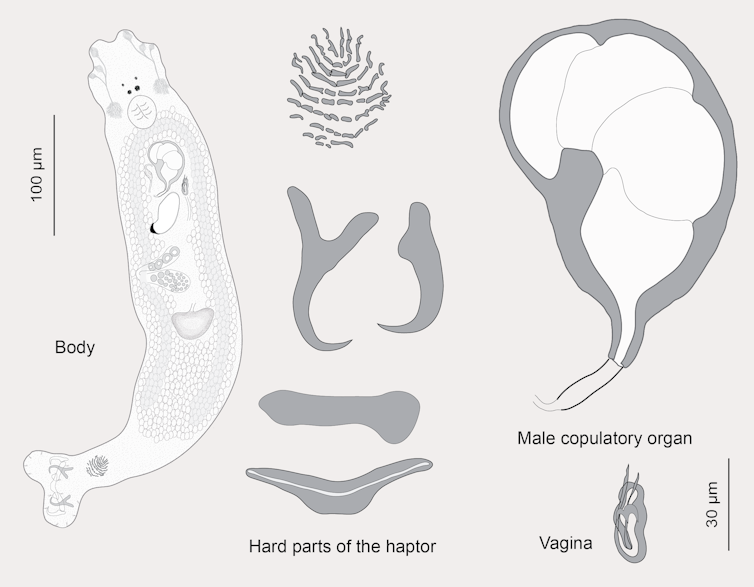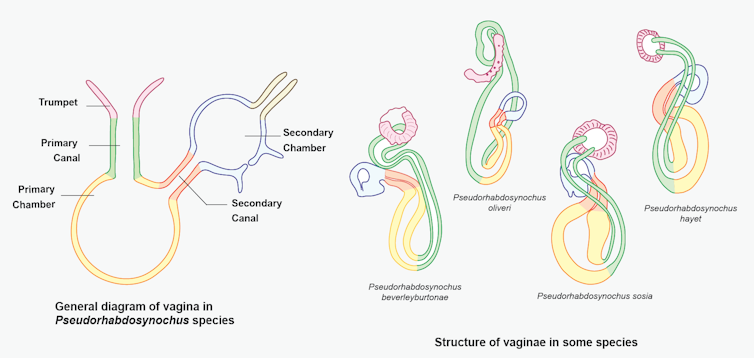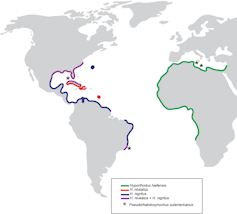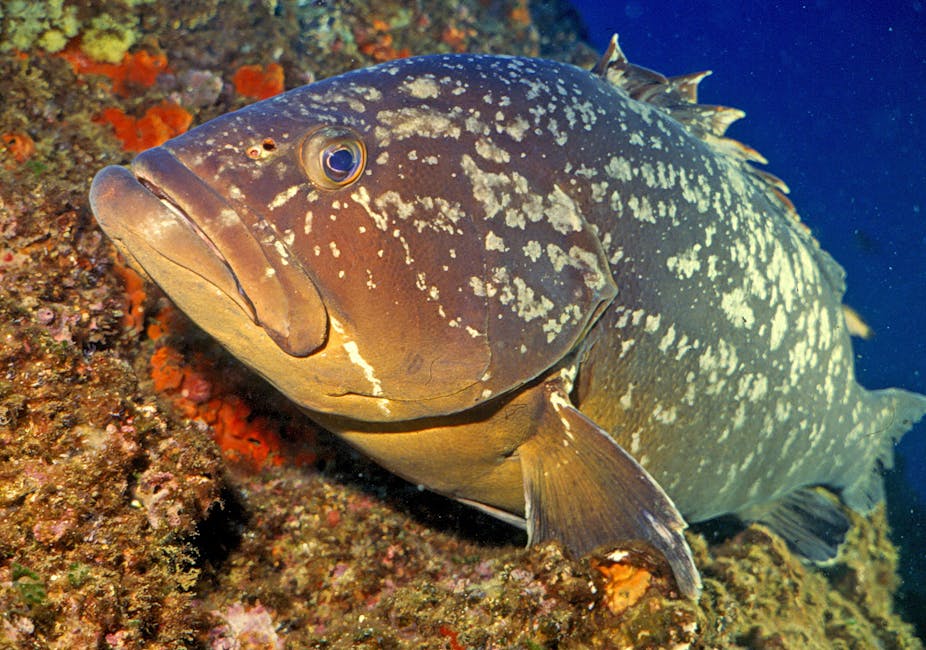“Parasite” is a term with a negative connotation, associated with laziness and predation, and the recent Oscar-winning movie Parasite will certainly not improve the public’s general opinion on the matter.
Parasite are animals that lives on or in another organism, the host, causing it some harm. However, for a biologist, parasites are fascinating and often represent the most interesting cases of evolution. In addition, parasites may well constitute the majority of life on earth, both in the number of species and individual animals. Almost all animals have parasites.
We chose to study the parasites of emblematic fishes, the groupers. Not all of them – only the tiny parasites called monogeneans living on the gills of these beautiful fish.

Monogeneans are tiny animals, less than 1 mm in length – you will hardly see them on a fish’s gill without a microscope. They attach themselves by their posterior end, with the anterior end free in the water. Attaching themselves firmly to soft tissue requires a special organ, the haptor, which contains sharp hooks that penetrate the gill’s surface.
The name “monogenean” was given by Belgian parasitologist Pierre-Joseph Van Beneden more than a century ago, and means that their life cycle involves only a single host fish. Once attached, adult monogenean never leave. Their larva can swim freely, however, enabling them to find another fish.
A very diverse genus
Studies in recent decades revealed that most monogeneans on the gills of groupers belonged to a single, hyper-diverse group. These monogeneans are generally “species specific”, meaning that they’re found only on one species of grouper. In addition, each species of grouper harbours several species of monogeneans – up to a dozen.
The multiplicity of grouper species and the broad range of parasites on each grouper allow these monogeneans to be hyper-diverse – more than 80 species are known, and there are probably many more. Most of these monogeneans belong to a single genus named Pseudorhabdosynochus.
A very special male organ and incredibly diverse female ones
Most zoologists spend a significant part of their time looking at sexual parts of the animals they study. Why? Because many species are superficially very similar, yet highly different in the shape of their genitalia. This is how evolution works, and having a different sexual morphology prevents incompatible species from copulating with each another, therefore avoiding wasting energy in mating that would not produce progeny.

In this aspect Pseudorhabdosynochus is certainly not disappointing, and for three reasons:
All its species are hermaphrodite, so for each individual there are two complete sets of sexual organs, one male and one female.
The genitalia are sclerotised: although the body of the worm is soft, the genitalia are made of hardened proteins.
The variety of sexual structures is outstanding.
All Pseudorhabdosynochus species have a male copulatory organ that is a highly specialised pump that inserts sperm into the female genitalia. How it exactly works is unknown: after all, this male organ, which is impressive when looked with a microscope, is about 100 micrometres in size – a tenth of a millimetre.

Moreover, species of Pseudorhabdosynochus are incredibly diverse in the structure of their vagina. It’s a complex sclerotised structure, with a “trumpet” followed by several “canals” and “chambers”; each species has a unique morphology. How the sperm travel through this vagina is again unknown – this is a very small structure, generally one-thirtieth of a millimetre. It is likely that these complex structures play a major role in the differentiation of species.
Read more: Understanding the evolution of parasitic worms by studying their spermatozoa
Parasites on the gills of groupers in the Mediterranean
Previous results had shown that the groupers in warm sea, including coral reefs, harboured a rich fauna of parasites, especially monogeneans on fish gills. When we decided to study monogeneans of Mediterranean groupers, there were only seven species of Pseudorhabdosynochus known from the five endemic grouper species.
We sampled fish from the fish markets of Tunisia and sometimes from nearby Libya. Groupers are among the most sought-after fish in this part of the world, and thus expensive. However, a single big grouper can harbour hundreds of monogeneans, so a few fish provide ample work for the passionate parasitologist (and, occasionally, opportunities for nice meals).
We found that groupers in the Mediterranean sea have a dozen species of Pseudorhabdosynochus. We could even describe three new species, i.e., species that were never seen by previous researchers. For these we assigned new names; one is Pseudorhabdosynochus hayet, from the mottled grouper. Although species names are technically Latin, this one is of Arabic origin – hayet, meaning life.
A parasite species with a puzzling distribution
The species we found on the Haifa grouper had a few surprises in store. This is a rare fish species found only occasionally at fish markets. Its Latin name is Hyporthodus haifensis; the genus Hyporthodus gathers a few species of deep-sea rare groupers. No monogenean had ever been reported from this fish, so, when we found one, we first thought that it was a new species. Therefore, we compared it with other species found in the world. To our surprise, it was identical to Pseudorhabdosynochus sulamericanus, a species from the western Atlantic. This species was previously reported from grouper species of the genus Hyporthodus off Brazil and Florida.

It was disappointing that a species of monogenean from the Mediterranean had a name evocating South America (that’s what sulamericanus means). Moreover, it was hard to understand how species of fish separated by 6,000 kilometres of open ocean could share the same parasite species. We considered several explanations. One is simply that ichthyologists know very little of the biology of deep-sea groupers: it could be that the three grouper species from the American and African sides of the Atlantic have opportunities to exchange parasites, somewhere in the Atlantic.
Are parasites responsible for the disappearance of Mediterranean groupers?
In the 1950s, diving pioneer Jacques Cousteau reported huge groupers living quietly just close to beaches and harbours along the French coast. Alas, groupers are now rare along the European shores of the Mediterranean, decimated by overfishing and pollution.
We can’t point our fingers at monogeneans, however – the influence of these tiny parasites on these big groupers is probably infinitesimal. Even if hundreds of them are on the gills of a fish, they probably have almost or no consequence on its health.
The situation, however, is very different in aquaculture. When groupers are reared in a small pond of seawater, monogeneans can proliferate exponentially and species of Pseudorhabdosynochus are a well-known cause of death. In nature, groupers are often solitary animals, separated from their congeners by large areas of clean, monogenean-free, seawater; groupers have invented social distancing. Unfortunately, that’s not the case for farm-raised groupers, sometimes with fatal consequences.
This article is published in collaboration with researchers from ISYEB (Institut de Systématique, Évolution, Biodiversité, Muséum national d’Histoire naturelle, Sorbonne Universités). Every month they propose a scientific chronicle of biodiversity: “En direct des espèces”. Objective: to understand the interest of describing new species and cataloguing living things.


